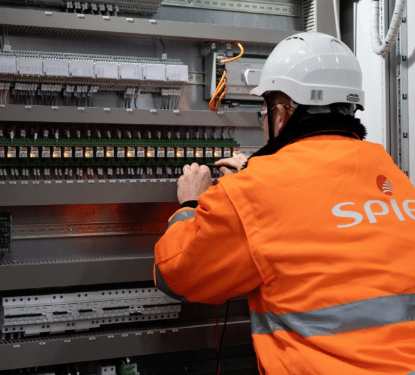The Internet of Things (IoT) is infiltrating every corner of the building. Systems like heating, ventilation and air conditioning (HVAC), lighting and access control have already been revolutionized by connectivity. More recently, elevators, windows, and furniture have been given a smart makeover. Now, a Toronto firm wants to go one step further by integrating IoT technology into walls, ceiling, and floors through their Intelligent Structural Panel (ISP) project that has caught the eye of tech giant Microsoft, who accepted them into its accelerator program.
“The Intelligent Structural Panel technology reimagines the traditional approach to the design and build process, taking a critical look at how buildings are built from the inside out. Bringing smart technology directly into the fabric of the structure instead of applying it as an after thought will improve the quality of the building’s performance,” says Zenon Radewych, principal at WZMH Architects.
Modeled after the Sandwich Plate System, ISP is an engineered, structural composite material that is produced as a prefabricated, modular component. Each unit houses as many as 20 different sensors to monitor different aspects of the built environment in real-time. The modules can, potentially, be manufactured more quickly, cheaply and greenly than traditional materials, therefore pleasing technologists, construction firms and environmentalists alike. For smart buildings, it could mark a new era where the structure of the building itself can interact with its occupants.
“Imagine that the floor beneath you is modular, a super-smart floor made of iPads–or rather tablets, because iPads are not made by Microsoft,” Radewych explains. By utilizing interior panels of building to sense humidity, temperature, smell, light, sound, among other things, then using that data to drive home and workplace ecosystems we gain unprecedented visibility and control. “This means that a building can become proactive to the needs of its inhabitants, instead of simply reactive,” says Radewych.
The Toronto based firm sees ISP being “a motherboard for buildings,” suggesting it could act as “a data highway” for the interior of buildings. Some units would offer plug-and-play ports for IoT devices and either Direct Current (DC) or Power over Ethernet (PoE) to power those devices. Radewych believes that data infrastructure, like plumbing or electrical wiring, should be considered and integrated from the earliest stages of construction not “as an afterthought.”
Follow to get the Latest News & Analysis about Smart Buildings in your Inbox!
“The future of smart buildings, and therefore smart cities, will be driven by connected devices and integrated solutions in buildings across the world,” he says, underlining the issue. “The lack of an international electrical standard has previously been a big hurdle to the IoT landscape.”
The ISP can be applied to numerous building types across a number of different sectors, such as offices, retail, residential, hospitality, healthcare, industrial, transportation and others. In each application, it could act as that built in data infrastructure, which ties together previously disparate systems while also offering to sense environments with a new level of detail. "Ultimately, the ISP is a solution geared towards leveraging the connectivity of technology to help make buildings more user friendly, barrier free, accessible, and safe."

WZMH Architects place a large focus on developing new technology, as they have done with ISP. “One of our former clients shared some advice that his father gave him many years ago: ‘Don’t stand still or you’ll get run over,’” says Carl Blanchaer, the longest serving partner. “Those words always ring in my head.”
In September, WZMH was the first architecture firm to be accepted and into Microsoft's global Internet of Things (IoT) Insider Labs, a program designed to accelerate businesses that are reshaping their industries by transforming the way people, devices and data interact. WZMH Architects along with Quasar Consulting Group, Stephenson Engineering and C3PoE have been accepted into this prestigious program thanks to their development of new building technologies.
Insider Labs offers investment and advisory consultants, meaning WZMH can get the support they need to bring this project to fruition. They say they are currently refining a prototype that could see test applications in the next six to 12 months.



